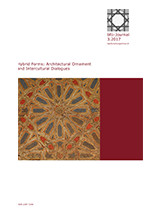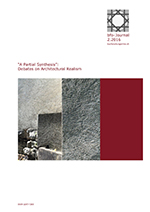
bfo-Journal 1.2015
Copy-Paste. The Reuse of Material and Visual Culture in Architecture
Download complete volume
Editorial
Francine GieseDownload PDF
Decorating with Things: Spolia as Material Culture in the Italian Maritime Republics, 1100–1300
Karen Rose Mathews
The Re-use of Byzantine Spolia in Rūm Saljūq Architecture
Richard Piran McClary
Multi-Perspective Gardens of Gabriel Guevrekian: Persian garden into cubist painting or cubist painting into Persian garden?
Zohreh Soltani
Iranischer Klassizismus: Konstruktion einer nationalen Identität
Elika Palenzona-Djalili
Bauen in Bagdad um 1958:
Wenn Bauvorhaben Revolutionen überstehen
Laura Hindelang
bfo-Journal 1.2015
Abstracts
Decorating with Things: Spolia as Material Culture in the Italian Maritime Republics, 1100-1300
Dr. Karen Rose Mathews
University of Miami
An extensive literature in archaeology and anthropology exists on material culture that addresses the relationships objects form with both people and things but this research has not been incorporated into the art historical study of spolia. In this article the dense spoliate assemblages on medieval structures in the Italian maritime republics of Pisa, Genoa, and Venice will serve as case studies for integrating art historical, anthropological, and archaeological discourses on material objects.
The Re-use of Byzantine Spolia in Rūm Saljūq Architecture
Richard Piran McClary
University of Edinburgh
This paper addresses the re-use of Byzantine spolia in the west of the Rūm Saljūq Sultanate during the early 7th/13th century. The focus is on two small mosques in Akşehir, along with two tombs in Konya and a madrasa near Isparta. The various symbolic, apotropaic and purely functional, structural uses of spolia are investigated and placed into the wider regional context.
Multi-Perspective Gardens of Gabriel Guevrekian: Persian garden into cubist painting or cubist painting into Persian garden?
Zohreh Soltani
State University of New York, Binghamton
The only surviving example of French modernist landscape design, Gabriel Guevrekian’s garden at Villa Noailles at Hyeres (1926-1927) has been described as “Persian”, “cubist”, “modern”, and “simultaneist”. The way the three dimensional Persian garden has been translated and abstracted into the spatial concept of cubism represents a tension between the planarity and spatiality of gardens as objects or spaces of art. This paper aims to push further these two competing aspects of these gardens – cubist and Persian – to illustrate the possibility of such coexistence.
Iranischer Klassizismus: Konstruktion einer nationalen Identität
Elika Palenzona-Djalili
Universität Zürich
Im Laufe des 19. Jahrunderts begann sich die Idee einer iranischen Nation bei den Intellektuellen und Staatsmännern zu formieren. Die Vorstellung der Europäer von der griechisch-römischen Antike als Ursprung der Zivilisation fand ihre Entsprechung in der Konstruktion einer iranischen Antike mit den vorislamischen Perserreichen der Achämeniden und Sasaniden als Ursprung der iranischen Zivilisation. Diese Gedanken schlugen sich in einer neuen visuellen Kultur nieder, indem achämenidische und sasanidische Bau- und Dekorelemente in das moderne Architekturrepertoire der Pahlavī-Dynastie (1924–1979) integriert wurden.
Bauen in Bagdad um 1958:
Wenn Bauvorhaben Revolutionen überstehen
Laura Hindelang
Universität Zürich
1955 wurde der italienische Architekt Gio Ponti beauftragt, einen Bürokomplex für das Iraqi Development Board und das irakische Entwicklungsministerium zu planen. Dieser wurde als einer der wenigen repräsentativen Bauprojekte für die Hauptstadt nach der Revolution von 1958 realisiert. In diesem Aufsatz wird ein Vergleich des Bagdaders Baus mit Pontis Pirelli-Hochhaus in Mailand angestellt und diskutiert, ob es sich um ein „Copy & Paste“ bautypologischer und architekturtheoretischer Konzepte handelt.





